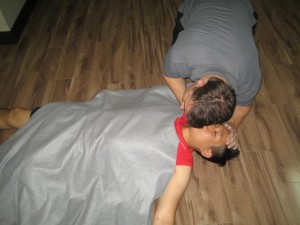Look For DANGER
Gauge the situation and make certain that the area is secure for you, the casualty and any other individuals that are there.
Look For RESPONSE
Ask the casualty their name and softly pinch their shoulders. Does the casualty react? If they do react, make the casualty comfy and continue to observe them while waiting for assistance. If the casualty does not react, they are possibly unconscious.
SEND For Assistance

Call for an ambulance or request somebody else to phone, and then carry on with the action plan.
Examine The AIRWAY
- Look for any objects in the airway
- Look if the airway is open
- If the airway is not obstructed, leave the casualty on their back and release their airway by leaning their head slightly back.
- If the airway is obstructed, place the casualty into the recovery position.
- Kneel down next to the casualty.
- Place the casualty’s arm at right angles in relation to their body.
- Then take the arm that is closest to you and place the arm across their chest.
- Curve the casualty’s leg up at the knee; then take the other leg and make it straight.
- Support the casualty’s neck and head; rotate the casualty away from you.
- When the casualty is on their side, make sure that their top leg is curved at the knee, with the knee touching the floor.
Examine For BREATHING
- Is the casualty’s chest increasing and falling?
- Do you hear the casualty breathing?
- If the casualty is not breathing, start CPR.
- If the casualty is breathing, put them in the recovery position and observe their breathing.
Provide CPR
- Kneel alongside the casualty while they are lying on their back; provide about 30 chest compressions near the breastbone. Take 2 hands with the fingers interconnected.
- You must try a chest compression rate of approximately 100 compressions per minute.
Related Video On First Aid For Emergencies
